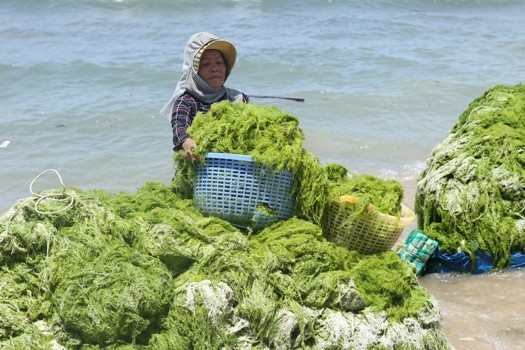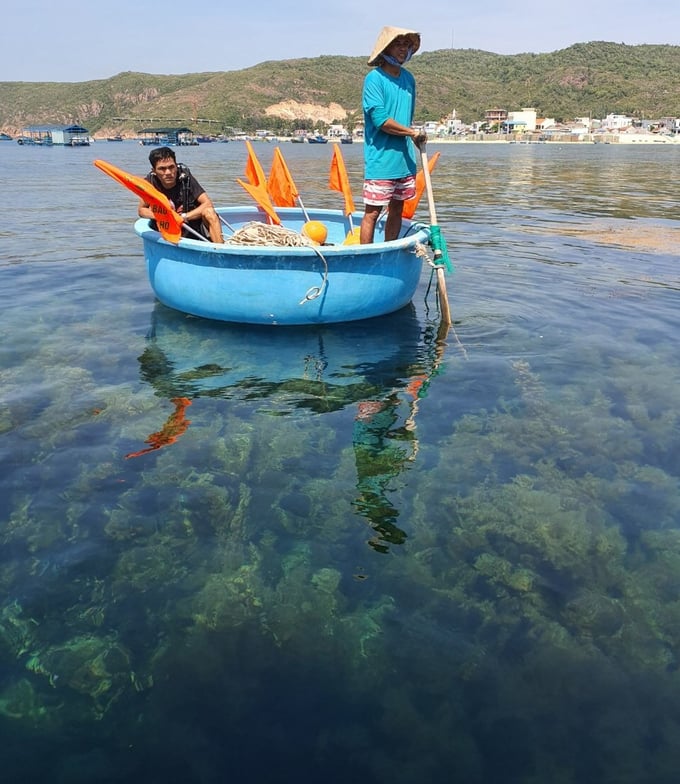November 24, 2025 | 05:08 GMT +7
November 24, 2025 | 05:08 GMT +7
Hotline: 0913.378.918
November 24, 2025 | 05:08 GMT +7
Hotline: 0913.378.918
Nhon Hai, a seaside fishing village in the city of Quy Nhon (Binh Dinh province), is home to a sargassaceae "forest" that serves as a "maternity hospital" for thousands of rockfishes every April to July during the breeding season. During this season, the waters of Nhon Hai are frequented by a variety of fish species, including cobia, seagrass rabbit-fish, parrotfish, and humphead snapper, the first of which has the largest school. The cobia's preferred food source is sargassaceae, which provides an abundance of nutrients for the rapid development of this species.
Prior to the establishment of the Community organization to protect fishery resources in Nhon Hai commune to protect corals, Nguyen Ton Xuan Sang, the director of the Nhon Hai Tourism and Fisheries Service Cooperative, stated that from early April to the end of July, locals used to rush the sea to harvest seaweed, which had become old. Currently, dried seaweed is marketed for around VND 1,300,000 per kilogram, and only 100 kilograms of dried seaweed are harvested annually. To safeguard coral reefs, seaweed harvesting is currently prohibited.

Seaweed exploitation.
According to the Directorate of Fisheries (D-fish), seaweed is a collection of plants that live in salty and brackish water along the coast, in estuaries, and on offshore islands. In marine ecology, seaweed and coral are two major ecosystems, and algae are compared to ecological forests where marine species may live and thrive. Seaweed is at the top of the marine food chain, regulating the marine environment and ecosystem by decreasing eutrophication, capturing and absorbing carbon, enhancing ocean acidification, and protecting coasts.
"In addition to being utilized as a food and supplement for people, seaweed is employed in several other industries, including food additives, animal feed, medicines, cosmetics, textiles, bio-fertilizers. chemicals, biostimulants, bio-packaging, and biofuels," Mr. Tran Dinh Luan explained.
Vietnam's coastline is more than 3,200 kilometers long, with several big and small islands spanning numerous latitudes. In addition to the climatic variability of coastal regions, surface flow, temperature, precipitation, and salt are all extremely beneficial for seaweed growth. Vietnam's seaweeds also have significant biological activity, which is quite useful.
Vietnam has documented a total of 827 species of seaweed, categorized into four groups: deep-blue seaweed, red seaweed, brown seaweed, and green seaweed. The Central area boasts the nation's greatest variety of seaweed species. Vietnam contains 88 kinds of economically valuable and cultivable seaweed. According to D-Fish, the potential growth area for seaweed in Vietnam is 900,000 hectares. However, the country has only planted 10,150 acres to date, so there is still plenty of space for growth.
According to the Agricultural Product Processing and Market Development Department (Ministry of Agriculture and Rural Development), the worldwide commercial seaweed market was valued at USD 16.6 billion in 2020 and is anticipated to increase at a quick annual pace of 10.8% from 2021 to 2028. The demand for seaweed is predicted to be driven by technical advancements in seaweed farming, as well as rising investments in industries such as animal feed and agriculture.

Natural seaweed is increasingly depleted due to the arbitrary exploitation of people. Photo: V.D.T.
It is anticipated that by 2050, human food demand would have increased by 70%, or by 5.4 million tons annually. However, the agricultural sector's ability cannot meet the above-mentioned growth in food demand due to the threat of land scarcity, lack of irrigation water, and climate change. As 70% of the earth's surface is the ocean, this is the driving force behind the development of the seaweed industry. Furthermore, the expansion of the seaweed farming areas is more favorable than that of other terrestrial crops, helping to ensure food security and nutrition for the growing global population.
Therefore, seaweed farming in many nations tends to be based on natural processes. With hundreds of varieties of seaweed, Vietnam has a significant market edge in this industry. Particularly cartilaginous seaweeds have been cultivated in Vietnam since the 1990s. This kind of seaweed was brought from the Philippines and is presently being farmed using cultivation techniques in the provinces of Ninh Thuan, Khanh Hoa, Phu Yen, and Binh Dinh. on rafts in open sea regions around the central coast, in shallow lagoons and semi-open bays with sandy or muddy bottoms, or in ponds.
Additionally, eucheuma seaweed is produced in shallow water and also in seas with a depth of 2 to 3 meters or more, with crops rotated in ponds and ponds along the coast to breed black tiger shrimp, and growing in net cages suspended from buoys in open coastal regions. With a production of 20 to 30 tons/ha/year, a selling price of around USD 0.1 per kilogram, and a net profit of over USD 48 million/ha/year, this is a viable source of income for coastal residents.
In response to the aforementioned reality, Vietnam will aggressively develop the seaweed business in the next years, with a target output of 180,000 tons by 2025, of which 170,000 tons will be gathered near shore and 10,000 tons will be harvested offshore. Vietnam's seaweed output will reach 500,000 tons by 2030, of which 400,000 tons will be gathered near shore and 100,000 tons will be harvested offshore.
To achieve the aforementioned objective, MARD will design methods and policies to promote the seaweed sector, as well as particular legislation, standards, technical norms, and manufacturing processes to serve as a management foundation. Implement existing credit policies and initiatives for agricultural and rural areas, including the seaweed industry. Create the ideal environment for enterprises and farmers to get access to loan funding for production and business development.
Specifically, MARD sets strategies to encourage local and international businesses to invest in cultivation and the development of seaweed processing facilities and seaweed-based products. It would encourage firms to invest in offshore seaweed cultivation and seaweed processing based on market needs and other species cultivation planned. Prioritization will be placed on the application of advanced technology to produce seaweed products with added value and to diversify product types. Investing particularly in preservation and extraction technologies to increase the value of seaweed.
Translated by Linh Linh

(VAN) Applying green technology in rural water supply and sanitation helps improve resource efficiency, protect the environment, and enhance community living standards.

(VAN) Developing biosecure livestock production is the key that helps Tuyen Quang form linked chains in livestock production and build its brand in the market.

(VAN) During his bilateral activities in South Africa, Prime Minister Pham Minh Chinh welcomed Vice President of the South African Chamber of Commerce and Industry Neil Pollock.

(VAN) Prof. Dr. Hoang Van Cuong, National Assembly Deputy of the 14th and 15th terms, shares recent pioneering policy decisions.

(VAN) Deputy Minister Tran Thanh Nam directed a comprehensive reform of the agricultural extension system, emphasizing professionalism and connecting farmers with the market.
/2025/11/22/3633-1-072521_760.jpg)
(VAN) The signing ceremony took place under the witness of Prime Minister Pham Minh Chinh and President of the Republic of South Africa Cyril Ramaphosa.

(VAN) Severe flooding in Khanh Hoa Province has caused catastrophic damage estimated at around USD 30 million, with the agriculture and irrigation sectors alone accounting for roughly USD 15.7 million in losses.